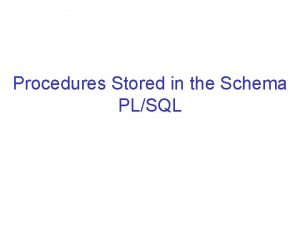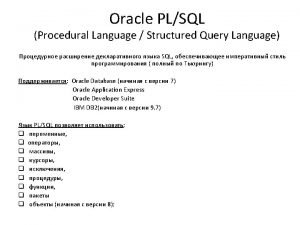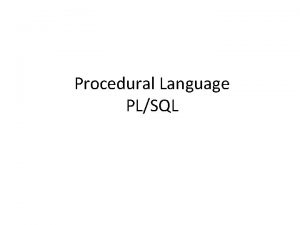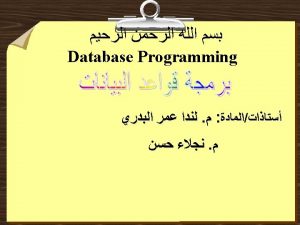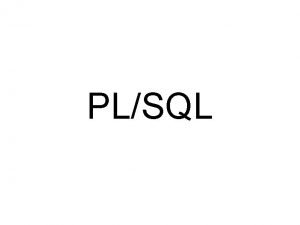Triggers PLSQL Types of Triggers You can create











- Slides: 11

Triggers - 觸發程序 PL/SQL



Types of Triggers � You can create triggers to be fired on any of the following: ◦ DML statements (DELETE, INSERT, UPDATE) ◦ DDL statements (CREATE, ALTER, DROP) ◦ Database operations (LOGON, LOGOFF)

Trigger names � Trigger names must be unique with respect to other triggers in the same schema. Trigger names do not need to be unique with respect to other schema objects, such as tables, views, and procedures. For example, a table and a trigger can have the same name; however, to avoid confusion, this is not recommended.

Trigger Syntax The syntax of a trigger varies database by database but for Oracle and PL/SQL (as well as for Enterprise. DB and SPL), the basic syntax of a DML trigger is: CREATE OR REPLACE TRIGGER trigger_name BEFORE|AFTER|INSTEAD OF INSERT|DELETE|UPDATE ON table_name [OF column_names] [REFERENCING [NEW AS new_cols] [OLD AS old_cols]] [FOR EACH ROW [WHEN (where_condition)]] [DECLARE] BEGIN EXCEPTION END;

REFERENCING clause � The REFERENCING clause allows you to name the old row and the new row. By default, they are named : OLD and : NEW. You refer to them as : OLD. column_name and : NEW. column_name. You can query them in both before and after row triggers, like: IF : old. gl_id = : new. gl_id THEN. . .

Creating a Trigger With the AFTER and FOR EACH ROW Option CREATE TABLE emp_audit ( emp_audit_id NUMBER(6), up_date DATE, new_sal NUMBER(8, 2), old_sal NUMBER(8, 2) ); CREATE OR REPLACE TRIGGER audit_sal AFTER UPDATE OF salary ON employees FOR EACH ROW BEGIN INSERT INTO emp_audit VALUES( : OLD. employee_id, SYSDATE, : NEW. salary, : OLD. salary ); END; UPDATE employees SET salary = salary * 1. 01 WHERE manager_id = 122; SELECT * FROM emp_audit;

Creating a Trigger With the BEFORE Option and WHEN Clause CREATE TABLE emp_sal_log (emp_id NUMBER, log_date DATE, new_salary NUMBER, action VARCHAR 2(50)); CREATE OR REPLACE TRIGGER log_salary_increase BEFORE UPDATE of salary ON employees FOR EACH ROW WHEN (OLD. salary < 8000) BEGIN INSERT INTO emp_sal_log (emp_id, log_date, new_salary, action) VALUES (: NEW. employee_id, SYSDATE, : NEW. salary, 'New Salary'); END; UPDATE employees SET salary = salary * 1. 01 WHERE department_id = 60; SELECT * FROM emp_sal_log;

Creating a Trigger That Fires Once For Each Update CREATE TABLE emp_update_log (log_date DATE, action VARCHAR 2(50)); CREATE OR REPLACE TRIGGER log_emp_update AFTER UPDATE OR INSERT ON employees DECLARE v_action VARCHAR 2(50); BEGIN IF UPDATING THEN v_action : = 'A row has been updated in the employees table'; END IF; IF INSERTING THEN v_action : = 'A row has been inserted in the employees table'; END IF; INSERT INTO emp_update_log (log_date, action) VALUES (SYSDATE, v_action); END UPDATE employees SET salary = salary * 1. 01 WHERE department_id = 60; INSERT INTO employees VALUES(14, 'Belden', 'Enrique', 'EBELDEN', '555. 111. 2222', '31 -AUG 05', 'AC_MGR', 9000, . 1, 101, 110);

Creating LOGON and LOGOFF Triggers CREATE TABLE hr_log_table ( user_name VARCHAR 2(30), activity VARCHAR 2(20), logon_date DATE, employee_count NUMBER ); CREATE OR REPLACE TRIGGER on_hr_logon AFTER LOGON ON HR. schema --(BEFORE LOGOFF ON HR. schema) DECLARE emp_count NUMBER; BEGIN SELECT COUNT(*) INTO emp_count FROM employees; INSERT INTO hr_log_table VALUES(USER, 'Log on', SYSDATE, emp_count); END;





